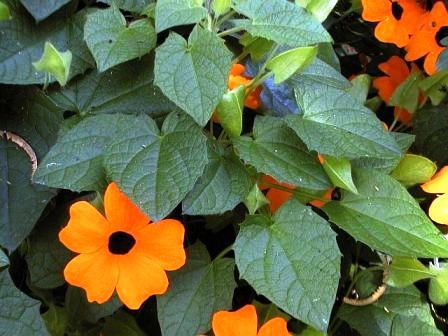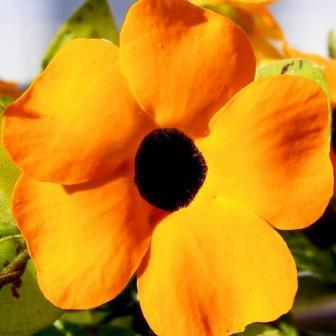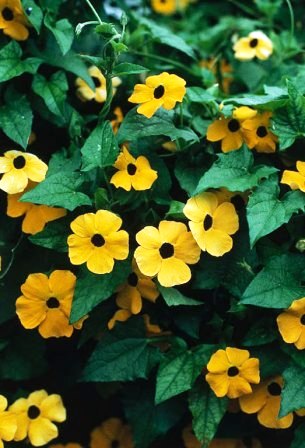5 Thunbergia alata Seeds - Black-Eyed Susan - Indigenous Creeper, Climber
Check my rate
| Main centres: | 1-3 business days |
| Regional areas: | 3-4 business days |
| Remote areas: | 3-5 business days |
Product information
In much of the warmer world, Thunbergia alata, or black-eyed susan, is well known as a fast-growing, long-flowering, friendly creeper. In South Africa it is a general favourite as it is not fussy about soil, needs only moderate water, doesn't go rampant, is mostly evergreen and covers ugly places beautifully. It has even been honoured in the standard set of South African postage stamps. Thunbergia alata is a soft, perennial climber about 1–5 x 1 m with many twining stems. The leaves are heart- or arrow-shaped, softly hairy and sometimes toothed. Many flowers are borne singly in leaf axils with a small calyx enclosed in 2 large, ridged bracts.
Thunbergia alata is not a threatened plant at present. Black-eyed susan is found from tropical Africa southwards through the eastern parts of Limpopo, Mpumalanga and Swaziland to KwaZulu-Natal and Eastern Cape. (It has long been cultivated so the natural areas are not clear.) It has become naturalized in Asia and Malesia and is invasive in Hawaii and Australia. In Africa it is usually found on forest margins but it can occur in dryer, open areas. It is sometimes seen along roads near settlements, but it does not seem to become a nuisance. It needs full sun or light shade. It is half-hardy, needing fairly warm conditions but, with protection, young plants can survive some frost. In cold areas treat it as an annual.
Thunbergia, named in 1780 by Retzius, honours Carl Peter Thunberg (1743–1828), a Swedish botanist, doctor, explorer and author who was perhaps the greatest pupil of Linnaeus. Thunberg spent three years collecting at the Cape of Good Hope, finding about 300 new plant species. He was so keen a collector that, when Japan was closed to all Europeans except the Dutch, he joined the East India Company as a surgeon so he could collect there. Seed of Thunbergia alata, named by Bojer, a German botanist, was sent from Mauritius to England where it was first described by Sims in 1825. (Surprisingly the plant had cream-coloured, not the common orange flowers.) The species name is from the Latin alatus, meaning winged. It refers to the winged petioles but it could also allude to the seeds that have projections looking rathings. Thunbergia alata is one of some 90 old world species of which there are 12 in South Africa. Other species in cultivation are T. natalensis, T. grandiflora Roxb., the blue-flowered Bengal clock vine, from India, and T. gregorii S.Moore, the golden glory vine, with strong orange flowers but no dark ‘eye', from tropical Africa and Ethiopia.
Black-eyed susan is probably pollinated by bees. An insect visiting the flower will touch the stigma first, with its back, and then the anthers, getting a load of pollen that is then carried to another stigma. The flowers reflect ultra violet light in a pattern that is visible to insects but not to humans. This helps insects find the centre of the flower. Seeds are perhaps ejected mechanically when the fruit splits open. A butterfly, Junonia ovithya, or the eyed pansy, and moths also visit these plants to lay eggs, for the larvae eat the leaves. Hence this creeper, being attractive to insects, helps bring birds into a garden. Birds also often nest in the thickly tangled stems. Used mainly as an ornamental plant, Thunbergia alata makes a good screen when used to cover unsightly dead trees or walls. It needs some support, as it cannot cling. Use fences, trellises, arches, arbours and pillars or a lightly shading tree. (Pergolas would probably be too big.) Alternatively, plant this creeper in groups as a ground cover, or on a bank or terraces where it can trail downwards. Hanging baskets are also a possibility. You're buying a pack of 5 Seeds We'll supply you with all the germination & care instructions. |



 The corolla is obliquely trumpet-shaped and is usually bright orange in wild plants. The inside of the tube is a striking dark maroon or purplish black. Nurseries also have variants with white, cream- or peach-coloured, yellow to deep orange or nearly red flowers. The fruit is like a bird's head with a spherical base and a long ‘beak'. This plant flowers all summer but can continue all year in warmer areas.
The corolla is obliquely trumpet-shaped and is usually bright orange in wild plants. The inside of the tube is a striking dark maroon or purplish black. Nurseries also have variants with white, cream- or peach-coloured, yellow to deep orange or nearly red flowers. The fruit is like a bird's head with a spherical base and a long ‘beak'. This plant flowers all summer but can continue all year in warmer areas.


